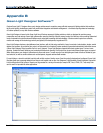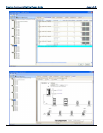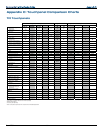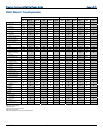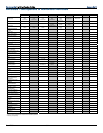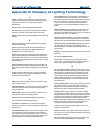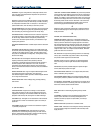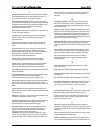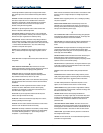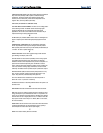
Commercial Lighting Design Guide Appendix E
Doc 4775A 99
DOWNLIGHT: A type of ceiling luminaire, usually fully recessed, where
most of the light is directed downward. May feature an open reflector
and/or shielding device
E
EFFICACY: A metric used to compare light output to energy consumption.
Efficacy is measured in lumens per watt. Efficacy is similar to efficiency,
but is expressed in dissimilar units. For example, if a 100-watt source
produces 9000 lumens, then the efficacy is 90 lumens per watt
ELECTROLUMINESCENT: A light source technology used in exit signs that
provides uniform brightness, long lamp life (approximately eight years),
while consuming very little energy (less than one watt per lamp)
ELECTRONIC BALLAST: A ballast that uses semi-conductor components
to increase the frequency of fluorescent lamp operation (typically in the
20-40 kHz range. Smaller inductive components provide the lamp
current control. Fluorescent system efficiency is increased due to high
frequency lamp operation
ELECTRONIC DIMMING BALLAST: A variable output electronic fluorescent
ballast
ELECTRONIC LOW-VOLTAGE (ELV): Electronic low-voltage lighting uses
an electronic (solid-state technology) transformer to convert line voltage
(120 VAC) to low voltage (typically 12 VAC). This lower voltage is then
used power an incandescent low-voltage lamp. Track lights are usually
electronic low-voltage
EMI: Abbreviation for electromagnetic interference. EMI is the high
frequency interference (electrical noise) caused by electronic
components or fluorescent lamps that interferes with the operation of
electrical equipment. EMI is measured in micro-volts, and can be
controlled by filters. Because EMI can interfere with communication
devices, the Federal Communication Commission (FCC) has established
limits for EMI
ENERGY-SAVING BALLAST: A type of magnetic ballast designed so that
the components operate more efficiently, cooler and longer
than”standard magnetic" ballast. By US law, standard magnetic ballasts
can no longer be manufactured
ENERGY-SAVING LAMP: A lower wattage lamp, generally producing
fewer lumens
F
FC: (SEE FOOTCANDLE)
FLUORESCENT LAMP: A light source consisting of a tube filled with
argon, along with krypton or other inert gas. When electrical current
is applied, the resulting arc emits ultraviolet radiation that excites the
phosphors inside the lamp wall, causing them to radiate visible light
FOOTCANDLE (FC): The English unit of measurement of the illuminance
(or light level) on a surface. One footcandle is equal to one lumen per
square foot
FOOTLAMBERT: English unit of luminance. One footlambert is equal to
1/p candelas per square foot.
FORWARD PHASE DIMMING: Rather than attempting to restrict the
amplitude of the current flowing through a lamp, as in other forms of
dimming, forward phase control works by switching off the beginning
part of each cycle of the alternating current supply
FOUR-WIRE 10V ANALOG SIGNAL DIMMING: Two power wires (switched
hot and neutral) and two additional control wires that are connected to a
low-voltage circuit. Note: these ballasts do not turn on and off like DALI
ballasts, so in addition to the low-voltage-level control circuit, they must
also have a line-voltage switch. Zero to ten-volt control is a low-voltage
DC dimming method. Power wires are rated Class 1 and control wires
are rated Class 2. This separation allows multiple circuits to use the
same dimming signal without additional power equipment
G
GLARE: The effect of brightness or differences in brightness within the
visual field sufficiently high to cause annoyance, discomfort or loss of
visual performance
H
HALOGEN: (SEE TUNGSTEN HALOGEN LAMP)
HARMONIC DISTORTION: A harmonic is a sinusoidal component of a
periodic wave having a frequency that is a multiple of the fundamental
frequency. Harmonic distortion from lighting equipment can interfere
with other appliances and the operation of electric power networks. The
total harmonic distortion (THD) is usually expressed as a percentage of
the fundamental line current. THD for 4-foot fluorescent ballasts usually
range from 20% to 40%. For compact fluorescent ballasts, THD levels
greater than 50% are not uncommon
HID: Abbreviation for high intensity discharge. Generic term describing
mercury vapor, metal halide, high-pressure sodium, and (informally)
low-pressure sodium light sources and luminaires
HIGH BAY: Pertains to the type of lighting in an industrial application
where the ceiling is 20 feet or higher. Also describes the application
itself
HIGH OUTPUT (HO): A lamp or ballast designed to operate at higher
currents (800 mA) and produce more light.
HIGH POWER FACTOR: Ballast with a 0.9 or higher rated power factor,
which is achieved by using a capacitor.
HIGH PRESSURE SODIUM LAMP: A high intensity discharge (HID) lamp
whose light is produced by radiation from sodium vapor (and mercury)
HOT RESTART or HOT RESTRIKE: The phenomenon of re-striking the arc
in an HID light source after a momentary power loss. Hot restart occurs
when the arc tube has cooled a sufficient amount
I
IESNA: Abbreviation for Illuminating Engineering Society of North
America.
ILLUMINANCE: A photometric term that quantifies light incident on a
surface or plane. Illuminance is commonly called light level. It is
expressed as lumens per square foot (footcandles), or lumens per
square meter (lux)
INDIRECT GLARE: Glare produced from a reflective surface.
INSTANT START: A fluorescent circuit that ignites the lamp instantly with
a very high starting voltage from the ballast. Instant start lamps have
single-pin bases




